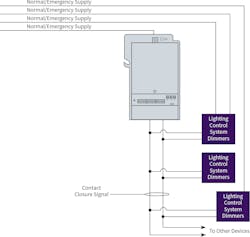How to Meet UL 924 Requirements for Emergency Lighting
Commercial buildings require emergency lighting to facilitate the safe egress of occupants in the event of a power outage or other emergency. Emergency specifications that meet UL 924, Standard for Emergency Lighting and Power Equipment, requirements ensure that the project has reliable and compliant emergency lights in the space.
As products and systems change, UL periodically revises its standards that may impact the emergency lighting design. Effective April 2022, UL 924 updated the requirements for compliant products. As a result of the change, a building’s UL 924-listed emergency lighting components must now actively monitor normal power to ensure emergency lighting is deployed within 10 seconds of power loss. This change eliminated some previously allowed methods. Fortunately, there are still a variety of ways to meet UL 924.
Depending on the controls and luminaires in the space, individual project needs, and the type of backup power used, emergency lighting implementation strategies vary considerably. Ultimately, the emergency solution must be reliable, comply with all project requirements while still meeting applicable codes (such as NFPA 70, National Electrical Code; NFPA 101, Life Safety Code; and NFPA 110, Standard for Emergency and Standby Power Systems), and achieve these three functions:
- Get power to the emergency luminaire during a utility power interruption.
- Force the emergency luminaire to a predetermined output level (often, but not always, 100%), bypassing any controls.
- Prevent the emergency luminaires from being turned off or bypassed before normal power is restored.
Emergency lighting design strategies
Before we review methods of implementing emergency lighting, it is useful to understand the relationship between UL standards and building codes. Building inspectors require the finished building to meet the relevant building codes, such as the NEC or International Building Code (IBC). Using UL-listed solutions is one way to meet these code requirements. However, emergency lighting systems can easily be designed to meet code requirements without each of the separate components bearing a UL 924 mark. For example, UL 1008, Standard for Safety Transfer Equipment, may be necessary for some situations. Therefore, when specifications are being written, it is better to reference the required building codes than the specific product standard that can be used to meet them.
There are four primary methods of implementing emergency lighting solutions.
Strategy #1: Standalone emergency luminaires
This solution utilizes dedicated luminaires that are always-on or turn on only upon loss of normal power. It can be deployed in three different ways:
- Dedicated emergency luminaires: Common in corridors and stairwells, these are powered by a central normal/emergency source and are on all the time. When normal power cuts out, the emergency power source (generator or inverter) takes over.
- Luminaires powered by emergency power only: These luminaires are off when normal power is present and come on with centralized emergency power only when normal power is lost.
- Integrated “bug-eye” luminaires with self-contained batteries: These luminaires are for installations where no central emergency power is present. They are connected to normal power that is used to charge the batteries. When normal power is present, the luminaires are off and the batteries are charging. When normal power drops out, the luminaires turn on.
This is a simple, code-compliant, distributed strategy. The stand-alone luminaires (that are installed in addition to general-purpose lighting) are not controlled by a lighting control system and may be fully illuminated even when a space is unoccupied. They offer virtually no flexibility, must be tested regularly, and batteries will eventually require maintenance or replacement.
Strategy #2: General-purpose luminaires with battery backup
In this scenario, certain general-purpose luminaires are designated as emergency luminaires. They use an emergency LED driver with an integral battery (one per luminaire). Under normal power, the battery is charged by means of a constant-hot connection to the emergency LED driver, while a separate normal (non-emergency) driver controls the LEDs. When normal power is lost, the normal driver loses power, and the LEDs are powered by the emergency LED driver and battery.
Emergency LED drivers are meant to provide illumination that satisfies the required footcandle levels for egress; these levels are typically below the full output capacity of the luminaire. Battery backup in the luminaires delivers power using general lighting luminaires that may be connected to a lighting control system. As with emergency-only luminaires, this is a distributed approach that does not enable adjustable emergency lighting levels and requires regular testing/battery maintenance (Fig. 1). However, this solution is viable for applications where no central emergency power is available.
Strategy #3: Zone-level automatic load-control relays (ALCR) and branch-circuit emergency lighting transfer switches (BCELTS)
If a central emergency power system is present, using ALCRs or BCELTS allows standard luminaires to be used for emergency lighting. This design strategy eliminates dedicated or specialty battery backup luminaires and enables integrated control via a lighting control system.
ALCRs are UL 924-listed devices that provide emergency power to lighting loads by bypassing the local control device in the event of power loss. In normal operation, the local control dims or switches the load. When normal power is lost, the ALCR bypasses the local control and provides the load with normal/emergency power, forcing it to full and locking out local control. This strategy does not rely on specialty emergency luminaires, but it does require the purchase and installation of the ALCR relays for each zone (Fig. 2).
With certain control types, such as some ELV or phase-adaptive dimmers, the power source to the luminaire must be switched completely from the control to an emergency feed. In these cases, a BCELTS, which is listed to UL 1008 rather than UL 924, must be used instead of an ALCR (Fig. 3).
To ensure the selection of the proper ALCR or BCELTS for specific applications, specifiers should seek guidance from the manufacturer or lighting control system vendor and reference emergency design documents.
ALCR or BCELTS solutions require no long-term maintenance (although they will still be subject to regular testing and verification), and some variations of these devices offer the ability to trigger emergency lighting via a contact closure from a third-party system, such as a fire alarm control panel (FACP).
The challenge of the ALCR approach is that they will always force the emergency lights on to 100% and can add overall hardware cost and wiring complexity to a project because an emergency relay is required for each zone of emergency lighting.
Strategy #4: Centralized emergency lighting control
For the most flexible, cost-effective, and robust emergency lighting solution, you can use the features of a centralized lighting control system, wherein one piece of equipment senses and activates emergency lighting for large parts of or even the entire lighting system. This is achieved using a central power-loss-sensing device (UL 924 listed) that sends a contact closure signal to a compatible lighting control system. The lighting control system then forces all pre-programmed emergency lights to a pre-defined level (not necessarily 100%). Like the ALCR/BCELTS solution, this strategy requires the use of a centralized emergency power source (Fig. 4).
A centralized emergency lighting strategy provides significant benefits. Neither dedicated emergency luminaires nor additional relays are required on emergency zones. Furthermore, emergency functionality can be easily configured via software, allowing designers to potentially select which luminaires are activated during an emergency, and even what light level each emergency zone may go to. Reduced emergency light levels may allow for use of a smaller generator, while still maintaining the minimum light levels required by code. Centralized emergency lighting can even be accomplished with wireless lighting control systems.
A centralized emergency lighting solution is the most future-proof and flexible option. Minimal additional hardware may be all that is necessary, and a centralized solution facilitates easy adjustments to system programming over time. Software-based changes can determine how luminaires respond in an emergency power situation versus a crisis condition.
Work with manufacturers that make the design process easier
As technologies advance, building owners and tenants expect more robust lighting performance, different sequences of operations, and a wider variety of lighting control protocols. Since there is no universal approach to emergency lighting, it’s important to approach every project as a unique design and include emergency lighting early in project discussions.
Rather than being a daunting prospect, designing an appropriate, integrated emergency solution can be simple when you work with a provider that offers end-to-end solutions for both normal and emergency zones and has support, technical expertise, and design tools to make it easy.
Ethan Biery is a senior systems applications engineering leader at Lutron Electronics, where he has worked for more than 20 years. He currently is the technical leader for Lutron’s global System Sales Engineering Team, which provides technical assistance, training, and support to Lutron’s global salesforce. Biery’s experience includes product design; LED technology, performance, and compatibility; and standards development.
About the Author
Ethan Biery
Ethan Biery is a senior systems applications engineering leader at Lutron Electronics, where he has worked for more than 20 years. He currently is the technical leader for Lutron’s global System Sales Engineering Team, which provides technical assistance, training, and support to Lutron’s global salesforce. Ethan’s experience includes product design; LED technology, performance, and compatibility; and standards development.





